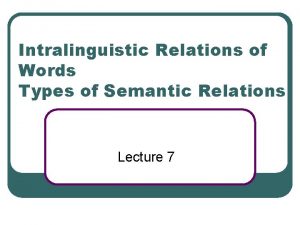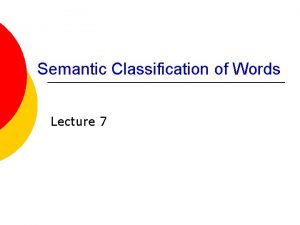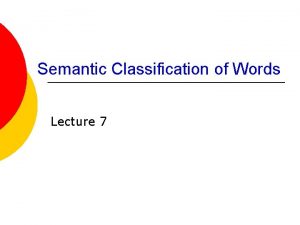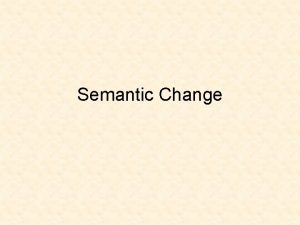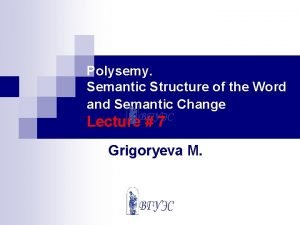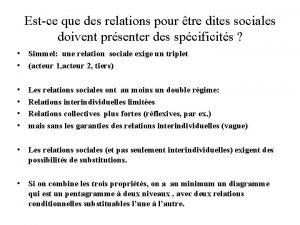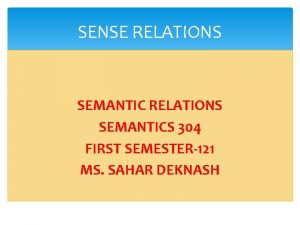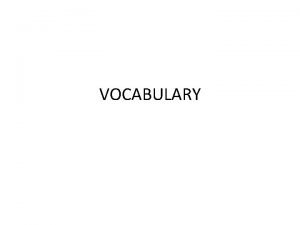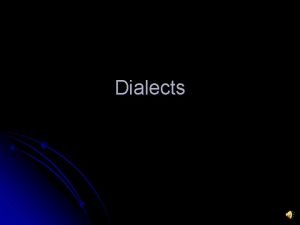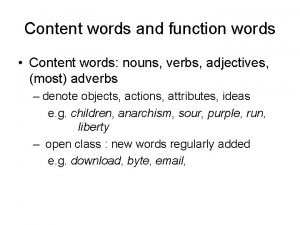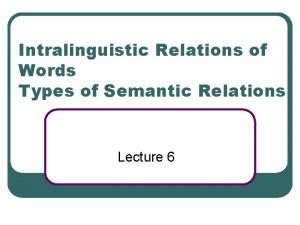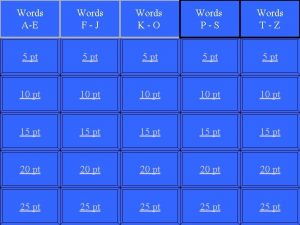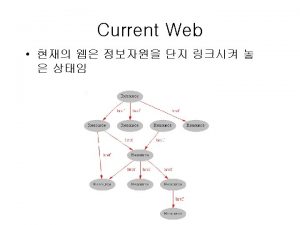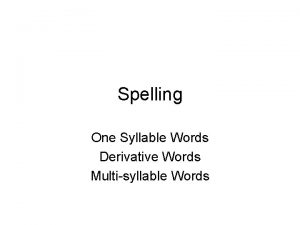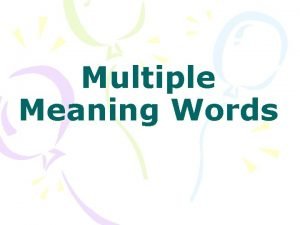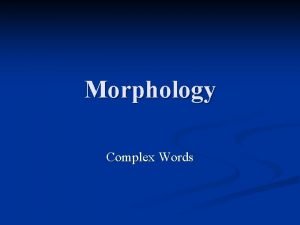Intralinguistic Relations of Words Types of Semantic Relations
















- Slides: 16

Intralinguistic Relations of Words Types of Semantic Relations Lecture 7

I. INTRALINGUISTIC RELATIONS OF WORDS 1. SYNTAGMATIC RELATIONS 2. PARADIGMATIC RELATIONS BASIC TYPES OF SEMANTIC RELATIONS 1. PROXIMITY 2. EQUIVALENCE 3. INCLUSION. HYPONYMIC STRUCTURES 4. OPPOSITION.

I. Intralinguistic Relations of Words Ferdinand de Saussure: l Intralinguistic relations that exist between words l They are basically of two types: syntagmatic and paradigmatic

1. 1. Syntagmatic Relations - 1. 2. 3. 4. are the relationships that a linguistic unit has with other units in the stretch of speech in which it occurs. He got a letter (to receive); He got tired (to become); He got to London (to arrive); He could not get the piano through the door (to move smth. to or from a position or place).

syntagmatic relations are linear relations between words l 1. 2. 3. The adjective yellow: colour: a yellow dress; envious, suspicious: a yellow look; corrupt: the yellow press

Context - the minimal stretch of speech determining each individual meaning of the word. l free or denominative meanings - the meaning or meanings representative of the semantic structure of the word and least dependent on context: table – a piece of furniture; make - construct, produce’

1. 2. PARADIGMATIC REALTIONS - are the relations that a linguistic unit has with units by which it may be replaced: sets of synonyms, pairs of antonyms, lexico-semantic groups, etc. E. G. to get synonymic set: to obtain, to receive, to gain, to acquire, etc.

The distinction between syntagmatic and paradigmatic relations is conventionally indicated by horizontal and vertical presentation.

II. BASIC TYPES OF SEMANTIC RELATIONS 2. 1. PROXIMITY Meaning similarity is seldom complete and is nearly always partial which makes it possible to speak about the semantic proximity of words and, in general, about the relations of semantic proximity.

The adjectives are characterized by certain features of semantic dissimilarity which shows that they are not absolutely identical in meaning Beautiful Extremely good-looking, much more so than most women Pretty Good-looking in an ordinary way but not really beautiful or sexually exciting Attractive Good-looking, especially in a way that makes you feel sexually interested Striking Very attractive, especially because a woman has a particular feature, such as hair or eyes, that is beautiful and unusual Handsome Good-looking in an unusual way, especially because a woman is tall or strong or looks as if she has a strong character

Proximity 1. 2. 3. red and green share the semantic features of ‘colour’, ‘basic or rainbow colour’, ‘complementary colour, ; red vs scarlet or green vs emerald may be graded in semantic proximity; table and chair share the semantic features of ‘thingness’, ‘object’, ‘piece of furniture’ that forms a good basis for grouping them together with other nouns denoting ‘pieces of furniture’.

2. 2. Equivalence l l l implies full similarity of meaning of two or more language units; is very seldom observed in words; Is oftener encountered in case of sentences: John is taller than Bill is shorter than John

2. 3. INCLUSION. HYPONYMIC STRUCTURE - type of semantic relations which exists between two words if the meaning of one word contains the semantic features ‘constituting the meaning of the other word’. The semantic relations of inclusion are called hyponymic relations: Vehicle: car, lorry, motorcycle, jeep… Hyperonym: hyponyms.

In hyponymic structure certain words may be both classifiers (hyperonyms) and members of the group (hyponyms):

2. 4. OPPOSITION is the contrast of semantic features which helps to establish the semantic relations 1) Polar oppositions are those which are based on the semantic feature uniting two linguistic units by antonymous relations, e. g. rich – poor, dead – alive, young – old. 2) Relative oppositions imply that there are several semantic features on which the opposition rests. The verb to leave means ‘to go away from’ and its opposite, the verb to arrive denotes ‘to reach a place, esp. at the end of a journey’.

 Hyponyms of plants
Hyponyms of plants Employee relations in public relations
Employee relations in public relations Semantic classification
Semantic classification Lassification
Lassification Semantic classification of words
Semantic classification of words Semantic narrowing
Semantic narrowing Polysemy in semantics
Polysemy in semantics Prnewsweek
Prnewsweek Les types de relations interindividuelles
Les types de relations interindividuelles Sense relation in semantics
Sense relation in semantics Public relations strategies and tactics
Public relations strategies and tactics Etymology
Etymology Ana greek root
Ana greek root Snarl words
Snarl words Southern words vs northern words
Southern words vs northern words Southern vs northern words
Southern vs northern words What is a content word
What is a content word
